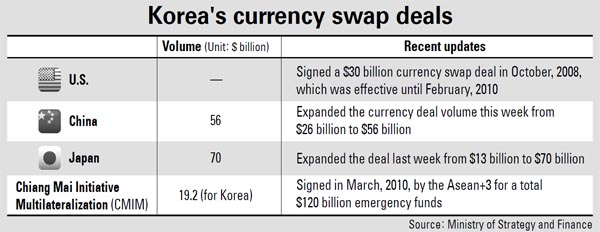Timing a key concern for currency swap with U.S.

But the situation quickly reversed - and the won and bourse surged - when news broke of a currency swap with the United States that permitted exchanges of up to $30 billion should either country fall short of foreign reserves.
“At that time, restoring confidence was of the utmost important and the currency swap with the U.S. made that happen,” said Vice Finance Minister Shin Je-yoon, who three years ago ranked as deputy finance minister.
“It was made possible because the two countries trusted each other,” he said over a recent lunch.
Even though conditions in the domestic market have started to stabilize as optimism builds over European policy makers’ efforts to save the region from a mounting debt crisis, industry officials fret that the worst is yet to come.
Seoul’s decision to expand its currency swap deals with Japan and China in the last two weeks stands as part of a broader goal of pre-empting a liquidity crunch.
Now observers are questioning whether it is time to follow suit with another Korea-U.S. deal after the previous one expired in February of last year.
“The impact of the two expanded swap deals with Japan and China is likely to be significant, but it would pale in comparison to a similar deal with the U.S. given the dollar’s status in the world market,” said an official from the finance ministry.
Last week, Korea signed an agreement with Japan expanding their currency swap arrangement to $70 billion from $13 billion. It followed this up with another pact with China raising the currency swap volume to $56 billion from $26 billion.
Industry analysts generally concur that Seoul should ink a similar deal with Washington to safeguard against another credit crunch. The government, without committing itself, has stated that this is a possibility.
“Credit rating agencies like Standard & Poor’s give higher evaluations to a country if it has more foreign reserves,” said Eun Sung-soo, head of the Ministry of Strategy and Finance’s international finance bureau.
Representatives from Moody’s, Fitch and S&P visited Seoul recently for their annual credit review and met with finance ministry officials, as well as others from the Financial Supervisory Service, Financial Services Commission and the Bank of Korea.
Each is expected to announce Korea’s credit rating within this year. At present, Fitch awards Korea a rating of A+, while Moody’s grants it A1 status and S&P deems its creditworthiness an A-grade.
“We’re ready [to sign the currency deal with the U.S.], but now is not the time,” said another high-level official from the finance ministry, speaking anonymously.
“Korea’s economic fundamentals are strong so another Korea-U.S. currency swap should be considered a last resort.”
The official said the government received “a verbal promise” from the United States in 2008 that it would offer its hand in times of crisis.
As of September, Korea’s foreign reserves stood at $334 billion. This jumps to $430 billion if the sums now available from Japan and China are factored in.
Meanwhile, the 10 Association of Southeast Asian countries and Korea, China and Japan signed a multinational currency swap deal in March of last year that effectively created an emergency fund of $120 billion based on the Chiang Mai Initiative. Korea can use up to $19.2 billion if required.
By Lee Eun-joo [angie@joongang.co.kr]










with the Korea JoongAng Daily
To write comments, please log in to one of the accounts.
Standards Board Policy (0/250자)